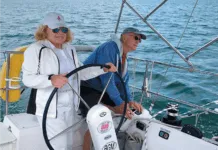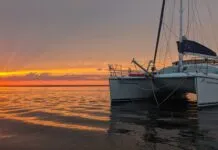Excerpted from The Weekend Navigator, Second Edition, Bob Sweet
Planning as You Go with GPS
Find Where You Are
Its always a good idea to keep a chart by the helm, preferably with your stored waypoints and routes marked on it for easy reference. On all but larger boats, which have space to lay out a chart, youll probably keep the active chart conveniently folded with the active area face up, so you can work with the chart on your lap. Unfortunately, when you do this, the latitude and longitude scales are often hidden from view. The following techniques will help you find your location without using these scales.
Location along an Active Leg
If you are following an active leg of a course or route, determining your position is greatly simplified. You can reasonably assume that you are somewhere along that course line. All you need do to confirm that is to look at your GPS Highway or Map Screen. Then, because stored GPS waypoints are also noted on the chart, even if the route leg itself is not plotted, draw a line from the waypoint you just left to the active waypoint youre headed toward. Now, where are you along that line? Here are some quick tricks to find out:
- Bearing to a Landmark – Simply sight on a charted feature to the side of your current course, usually a landmark or a buoy. It is enough to estimate a relative bearing quickly by eye; then on the chart, align your plotting tool to that relative bearing and move it to intersect the charted feature. See where it intersects your course line? You are there!
- Using a Grid Line – Scan along your active course line. Is there a plotted grid line (a line of latitude or longitude) on the course in front of you? If so, you can do your planning from where that grid line intersects your course line. Now all you need to do is proceed along the course line and watch your GPS display until you reach that precise latitude or longitude. You then know where you are.
- Using a Waypoint – Obviously, if you wait until you reach your current active waypoint, you will know where you are. Alternatively, you can use another waypoint stored in the GPS or a charted object near your course line. This is a variation on the bearing approach, but here you are looking for a nearby object. The easiest and safest way to do this is with a beam bearing to that object. Plan from that spot, and use your skilled mariners eye to identify when you have reached that location. If you are planning to use a stored waypoint that does not represent a buoy or other visible, charted feature, use the Map Screen to eyeball when this waypoint is abeam of your course. The closer the object is to your course line, the more accurate your established position will be.
For more advice on navigating with your GPS and other electronics, purchase The Weekend Navigator from Practical Sailor.




































